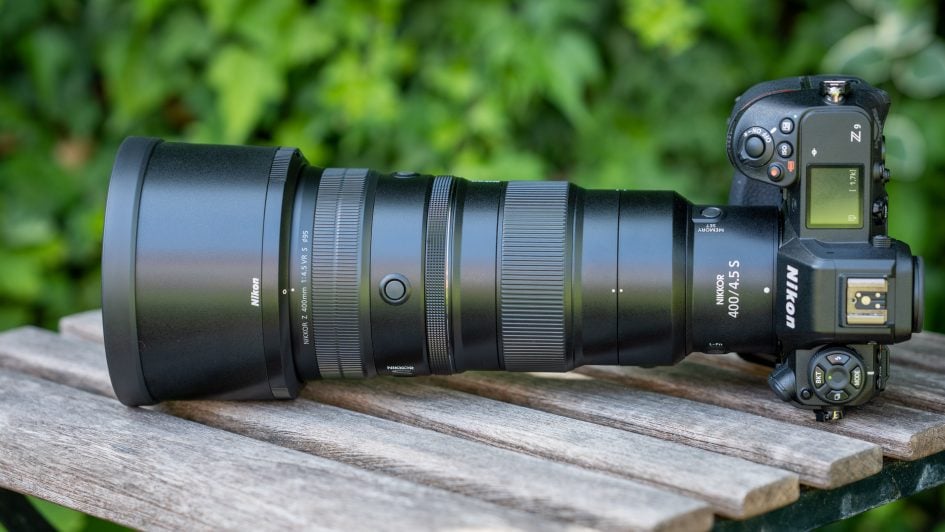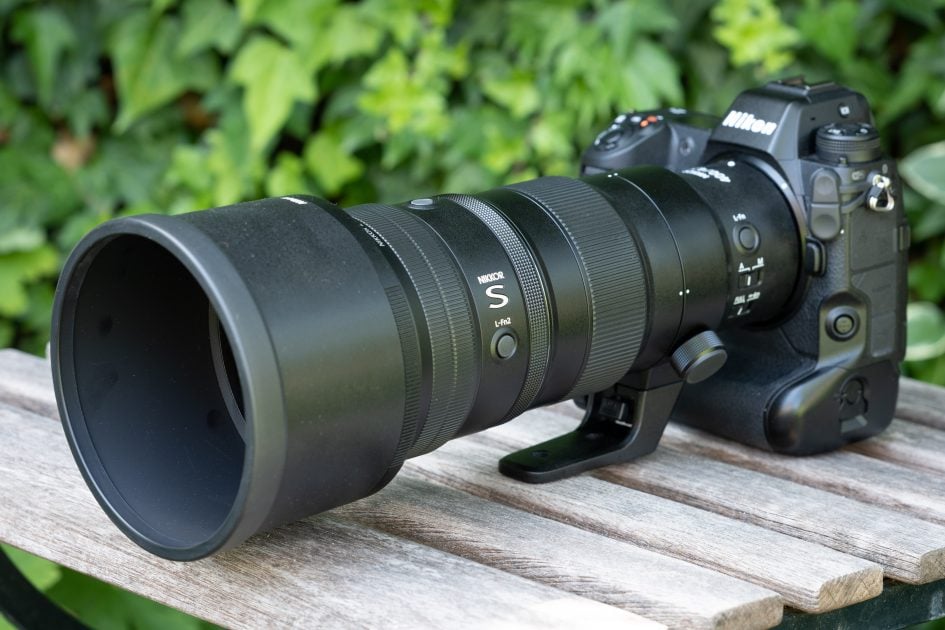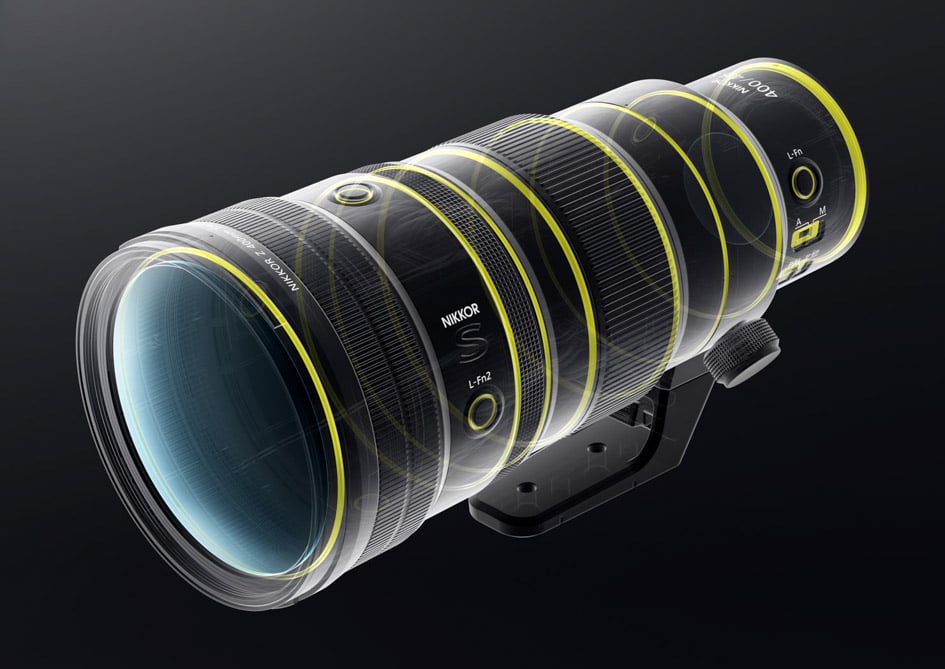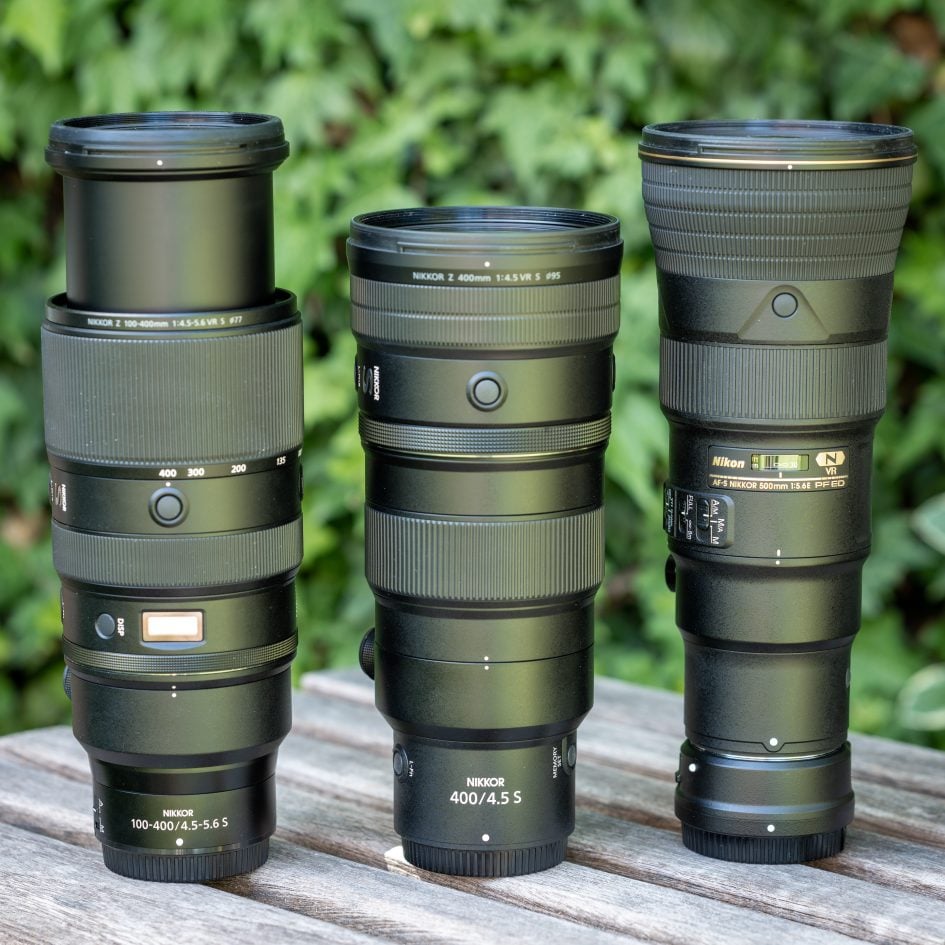Nikon Z 400mm f4.5 VR S review
-
-
Written by Thomas
Intro
The Z 400mm f4.5 VR S is Nikon’s second 400mm telephoto prime lens for Z-mount after the Z 400mm f2.8 TC VR S. Unlike the Z 800mm f6.3 VR S the new lens does not sport a Phase-Fresnel (PF) element but remains shorter than the Z 100-400mm f4.5-5.6 VR S when it’s extended to the 400mm focal length and at only 1245g, it’s lighter too, despite being 2/3 of a stop brighter.
The Z 400mm f4.5 VR S is corrected for full-frame cameras and is compatible for use with Nikon’s Z-mount teleconverters TC-1.4x and TC-2.0x. This allows it to be converted into a 560mm f6.3 or even 800mm f9 lens. Used on a cropped body like the Z fc or Z50 (or in DX-mode on any full-frame Z camera) it delivers a field of view equivalent to 600mm, 840mm or even 1200mm focal length (depending on the use of TCs). The lens offers optical image stabilization, focus limiter, removable tripod foot, additional function buttons plus a dedicated memory set button to save focus positions, but no OLED display.
The Nikon Z 400mm f4.5 VR S is made in China, costs 3699 EUR / 3250 USD / 3299 GBP, and became available mid July.
Facts and features
Let’s compare the Nikon Z 400mm f4.5 VR S (“Z 400/4.5” for short) to the Nikon Z 100-400mm f4.5-5.6 VR S (“Z 100-400”) and their Z 400mm f2.8 TC VR S (“Z 400/2.8”). I’ve also added information on Nikon’s AF-S 500mm f5.6E PF ED VR (“F 500/5.6”) and AF-S 300mm f4E PF ED VR (“F 300/4”) both of which employ Phase-Fresnel elements to reduce size and weight and can still be used via FTZ adapter on Nikon’s Z cameras. As usual I’ve rated the features with a [+] (or [++]), when it’s better than average or even state of the art, a [0] if it’s standard or just average, and [-] if there’s a disadvantage.
Size (diameter x length): At 104 x 235mm (4.1 x 9.3in.), the Z 400/4.5 is a pretty compact design. The lens hood adds 77mm. The Z 100-400 is 98 x 271mm (at 400mm focal length) + 65mm lens hood, the Z 400/2.8 is 156 x 380mm + 127mm lens hood. The F 300/4 is 89 x 148 mm + 62mm lens hood, the F 500/5.6 is 106 x 237mm + 73mm lens hood. Add 30mm for the FTZ adapter to use the F-Nikkors on a Nikon Z camera. [+]
Weight: 1160g (2.56 lb.) plus 85g tripod foot plus 132g for the plastic lens hood. The Z 100-400 is 1437g including foot + 63g lens hood, the Z 400/2.8 is 2936g including foot + 232g lens hood. The F 300/4 is only 735g (w/o tripod collar) + 60g lens hood, the F 500/5.6 is 1456g incl. foot + 91g lens hood. Add another 133g for the FTZ adapter to use the F-Nikkors on a Nikon Z camera. [+]
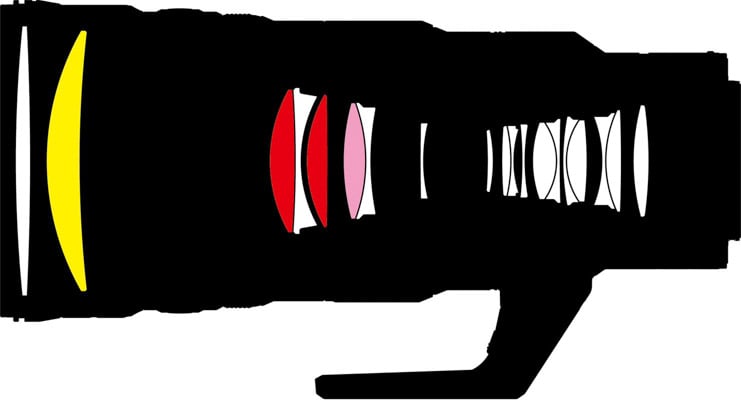
Optics: 19 elements in 13 groups including 4 special dispersion elements but no aspherical element – and to the surprise of some no Phase-Fresnel element. The lens has Nikon’s Nano-coating to reduce flare, glare and ghosting plus fluorine-coating on the front element to repel water, dust, and dirt and make cleaning easier. The Z 100-400 has 25 elements in 20 groups, the 400/2.8 has 18/15 elements/groups when the built-in 1.4x TC of the lens is switched off. The F 300/4 is 16/10, the F 500/5.6 is 19/11. [+]
Closest focus distance is 2.36m (7.7ft.) with a working distance of 2.11m and a maximum magnification of 1:5.6 which is not much but similar to what the F 500/5.6 offers. The Z 400/2.8 offers a maximum magnification of 1:3.9 when the built-in 1.4x TC is switched on, the Z 100-400 reaches 1:2.5, the F 300/4 reaches 1:3.4. [0]
Image stabilization: All lenses in this comparison offer optical stabilization (VR) which works in conjunction with the body-based stabilization on Nikon’s full-frame Z cameras. But only the Z-Nikkors profit from the full stabilization over 5 axes while for F-Nikkors the Z cameras only add roll correction to pitch and yaw correction from the lens’s VR. Nikon claims a stabilization effect of 5.5 stops, or 6 stops when used on a Nikon Z9 with “Synchro-VR”. [+]
Filter-thread: The Z 400/4.5 needs large 95mm filters just like the F 500/5.6. The Z 400/2.8 has an integrated slot for 46mm filters while the Z 100-400 and F 300/4 use 77mm filters. [0]
Autofocus: Yes with built-in AF stepper motor drive. Manual-focus override is by simply turning the dedicated focus ring at the middle of the lens. On Nikon Z cameras introduced October 2020 or later you can reverse focus direction. The focus ring has the usual variable gearing (like all AF Z-Nikkors so far) which allows for very precise manual focus when turned slowly and can be switched to linear response with a choice of different rotation angles – but only on a Nikon Z9 or a Z6/7 II with firmware 1.4. Focus on the F-Nikkors works differently as they have a direct linear mechanical coupling between the focus ring and the focus action. [+]
Display: No, the Nikon Z 400mm f4.5 VR S like the Z 400/2.8 does not feature the OLED display of the Z 100-400 which indicates focal length, aperture, or focusing distance and depth-of-field. The F-Nikkor sports the usual distance and dof indicators on the focus ring. [0]
Additional functions: There are 4 function buttons at the front (L-Fn2) and an additional L-Fn button behind the tripod collar on the lens which can be assigned different functions like AE/AF lock like on the Z 400/2.8. There’s also a memory set button to save focus positions on the right side close to the camera. But the Z 400/4.5 does not offer the additional function ring of the Z 400/2.8. All lenses in this comparison also sport a focus-limiter which in case of the Z 400/4.5 prevents the lens to search focus closer than 6m (20ft.). [+]
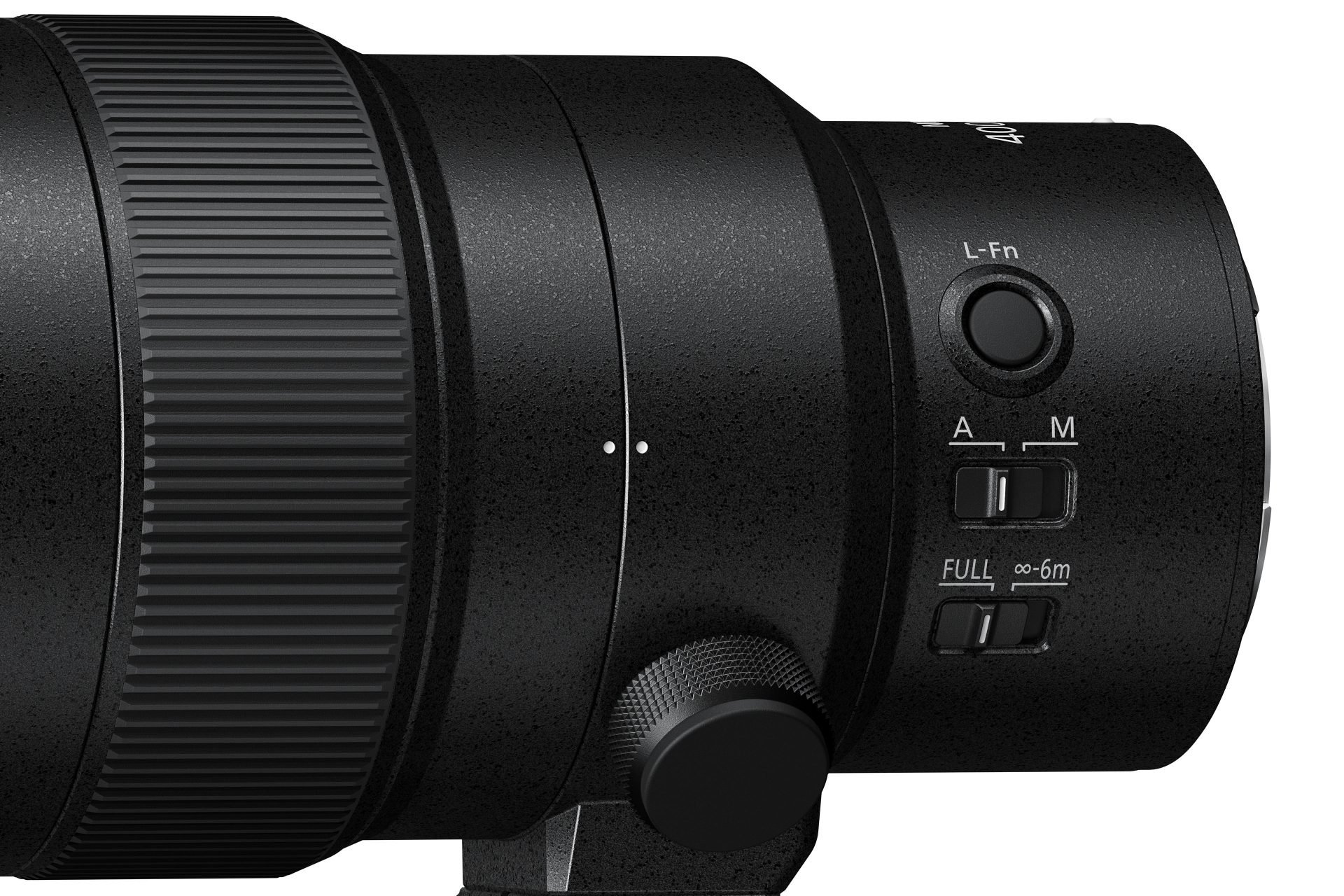
Aperture ring: The lens has the usual slim multi-function control ring which on the Z 400/4.5 is located in front of the focus ring. The control ring can be assigned to operate the aperture (which is the default), exposure compensation, or ISO sensitivity – or simply switched off. This is the same as with the Z 100-400 and Z 400/2.8 while the F-Nikkors have no dedicated aperture ring. [+]
Lens profile: All five lenses come with a lens profile which can be controlled from the camera. Vignette control offers the usual options of High, Normal, Low and Off. Diffraction compensation and Auto distortion control can be activated or deactivated. [+]
All lenses in this comparison cover full frame/FX or smaller sensors. [+]
Price: 3699 EUR (incl. 19% VAT) / 3250 USD / 3299 GBP. This makes it more expensive than the Z 100-400 which is around 3000 EUR / 2700 USD / 2700 GBP but similarly priced to the F 500/5.6 at 3550 EUR / 3300 USD / 3430 GBP. The Z 400/2.8 is 15000 EUR / 14000 USD / 13500 GBP, the F 300/4 is around 2000 EUR / 2000 USD / 1800 GBP. [0]
Use with teleconverters: Yes, the Z 400/4.5 can be used with the Z TC-1.4x and Z TC-2.0x, just like the Z 100-400 and the Z 400/2.8 (which has a 1.4x teleconverter already built-in). Keep in mind though that the Z TCs cannot be used with the FTZ adapter. The F-Nikkors need Nikon’s F TCs which are available as 1.4x, 1.7x, and 2x. [+]
The Z 400/4.5 comes with the usual flimsy pouch with no strings to pull it close. The lens hood is included and locks in place to avoid accidentally falling off plus it is reversible for transport and has a rubberized front-end. The Z 400/4.5 has a detachable tripod foot which is identical to the foot of the Z 100-400. Nikon missed out (again) to add an Arca-Swiss compatible groove to the foot. But you can swap a (replacement) foot between the Z 400/4.5 and Z 100-400 (and Z 70-200mm f2.8 VR S). Under the rubber cap of the screw is a security slot for attaching an anti-theft cable. [0]
Sealing: yes. All five lenses have a rubber grommet at the lens-mount. Plus there’s further special weather-sealing throughout the construction – except for the F 300/4. [+]
At a score of 0[-]/5[0]/11[+] the Nikon Z 400mm f4.5 VR S is a well featured lens: It’s small, lighter than the Z 100-400mm f4.5-5.6 VR S or AF-S 500mm f5.6E PF VR, and can be used with teleconverters. With its bright f4.5 focal ratio and very good image quality and stabilization this lens should make for a fine companion for those who like hiking and capturing nature’s and wildlife’s beauty without weighing themselves down. Only its maximum magnification of 1:5.6 is a bit disappointing but you can use a teleconverter to improve this up to 1:2.8.
Above from left to right: Nikon Z 100-400mm f4.5-5.6 VR S, Nikon Z 400mm f4.5 VR S, Nikon AF-S 500mm f5.6E PF VR (on FTZ adapter)
Coverage
If you’ve owned or used a 300mm or 500mm lens you might be interested how the Nikon Z 400mm f4.5 VR S fits in either with or without teleconverter. Here is the angle of view of the different options (Auto distortion control activated) shot from the same viewpoint as in all my reviews:
Above: Nikon Z 400mm f4.5 VR S (left), Nikon AF-S 300mm f4E PF VR (right)
Above: Nikon Z 400mm f4.5 VR S plus Z TC-1.4x (560mm, left), Nikon AF-S 500mm f5.6E PF VR (right)
The differences between the focal lengths do not seem too big. But the amount of pixels you lose should you need to crop e.g. a 300mm shot to the angle of view of a 400mm lens is 44%. That means you end up with a 25MP image from your 45MP camera – which might still be enough for the intended purpose. Cropping a 400mm shot to match the angle of view of a 500mm lens reduces your resolution from 45MP to 29MP.
Focus
Focus accuracy and repeatability is critical to consistently produce sharp shots. Repeatability (the accuracy of focus on the same subject after repeated focus-acquisition) of the Nikon Z 400mm f4.5 VR S was measured 98,2% in Reikan FoCal. This is very good, similar to the Nikon Z 100-400mm f4.5-5.6 VR S and better than the Nikon AF-S 500mm f5.6E PF VR. There were no outliers over a series of 40 shots on the well lit and contrasty focus test target and quality of focus did not depend on the direction focus came from. On a Nikon Z7 the lens focuses in around 0.7 sec from infinity to 4.1m (1:10 magnification). This is as fast as the F 500/5.6 and a bit faster than the Z 400/2.8. But the Z 100-400 is even a bit faster than the Z 400/4.5. On a Nikon Z9 the lenses focused quite a bit faster: The Z 400/4.5 and F 500/5.6 in 0.45 sec and the Z 100-400 in 0.5 sec. Focus hunting was not an issue during my time with the Z 400mm f4.5 VR S.
The focus ring is 29mm wide, has a rubberized surface, and moves smoothly. It’s located over the tripod foot. When using the lens hand-held turn the foot out of the way (or detach it) if you want to use the focus ring.
AF-operation and VR of the lens is virtually silent be it in photo-mode or if you record video with the built-in microphone.
As you pull focus, you’ll notice quite some focus breathing: the image became 9% more magnified when I adjusted focus from infinity to 4.1m. This is only half of what the Z 400/2.8 shows and also a little better than from the F 500/5.6 but is still quite visible when shooting videos. The Z 100-400 is practically free of focus breathing.
Image stabilization
To test the effectiveness of the image stabilization with the Nikon Z 400mm f4.5 VR S on a Nikon Z9 camera body with “Synchro-VR”, I did a series of 160 test-shots hand-held free-standing with shutter speeds from 1/640 of a second down to 1/10 sec. I used the shots at 1/640 sec with VR=off as reference of how good my hand-holding was at the time of the test and Reikan FoCal did the chore of evaluating the sharpness of all shots.
Here’s the results: With VR=on the combined stabilization from lens and camera produced no outliers in the 80 shots from 1/640 down to 1/80 sec (3 stops) with results at 1/80 better on average than sharpness at 1/640 sec with VR=off. At 1/40 sec (4 stops) I had 2 outliers in 20 shots but average image quality was a bit reduced. At 1/20 sec (5 stops) results became clearly erratic but were on average still pretty sharp with 4 outliers in 20 shots. At 1/10 sec (6 stops) average image quality dropped by about 20% with two outliers even clearly below that level. This is quite an impressive performance of the combined optical and sensor-based image stabilization but seems a bit below Nikon’s claimed 6 stops.
Next check out my quality results!
Check prices on the Nikon Z 400mm f4.5 VR S at B&H, Adorama, WEX UK or Calumet.de. Alternatively get yourself a copy of my In Camera book, an official Cameralabs T-shirt or mug, or treat me to a coffee! Thanks!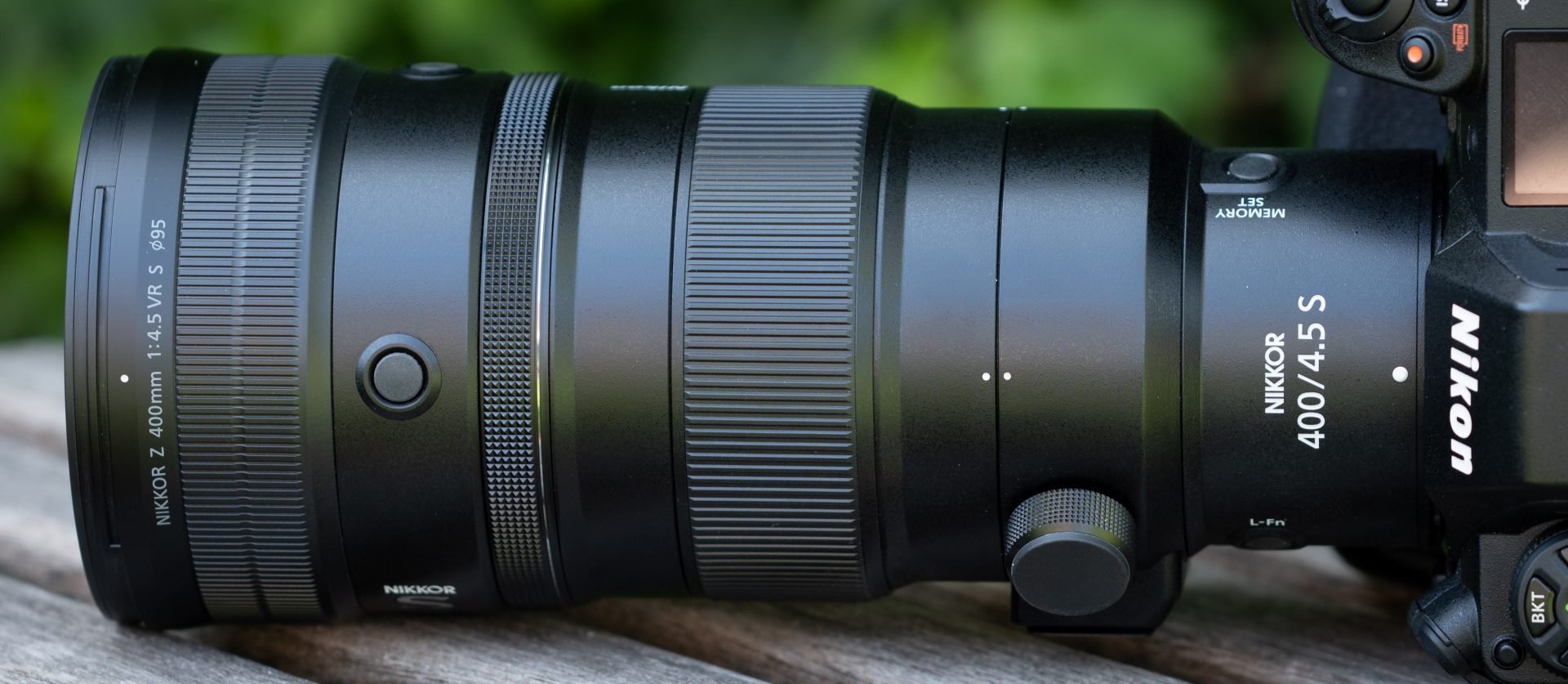
 Nikon’s Z 400mm f4.5 VR S is a very good telephoto prime lens of an unrivalled low weight. The lens produces very sharp images with virtually no field-curvature or colour aberrations and can confidently be used wide open. Combined with Nikon’s Z TC-1.4x teleconverter it still delivers good image quality but using the TC-2.0x taxes the abilities of the lens a bit. Its Bokeh is very nice and the optical image stabilization of 5 stops proves really helpful with the challenges of hand-holding an 400mm lens. All this makes the Z 400mm f4.5 VR S Highly Recommended.
Nikon’s Z 400mm f4.5 VR S is a very good telephoto prime lens of an unrivalled low weight. The lens produces very sharp images with virtually no field-curvature or colour aberrations and can confidently be used wide open. Combined with Nikon’s Z TC-1.4x teleconverter it still delivers good image quality but using the TC-2.0x taxes the abilities of the lens a bit. Its Bokeh is very nice and the optical image stabilization of 5 stops proves really helpful with the challenges of hand-holding an 400mm lens. All this makes the Z 400mm f4.5 VR S Highly Recommended.